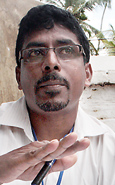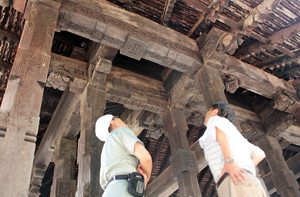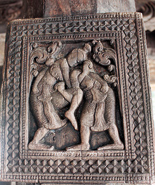Carving out a future for this wooden wonder
The climate in Kandy is not as cool as one would assume it to be, this close to December. The sun is beating down and just outside the ancient devalaya of Embekke, some eight kilometres off Pilimatalawa on the Colombo-Kandy main road, a crowd throngs a lottery ticket vendor – believing that the Kataragama Deviyo would bring them luck. The tickets sell like hot cakes. Inside the temple though, a group of Japanese and Sri Lankans are closely examining the wood carvings that Embekke is famous for, totally engrossed in their work.

Chief draftsman: Priyanka Basnayake
They are here for a workshop organised by the Asia-Pacific Cultural Centre for UNESCO (ACCU NARA) on the protection of cultural heritage, to record, document and research methods for wooden structures while formulating conservation and management strategies.
Some 15 officers from the Department of Archaeology, Central Cultural Fund, and the National Museum Fund were at the workshop, held from October 21-26. “This workshop allows us to gather much needed information about the documentation of wooden structures, and it is usually considered the first step in conservation,” said Acting Assistant Director (Promotions) of the Archaeology Department, Rasika Dissanayaka. Mr. Dissanayaka explained that the ACCU NARA was training them in proper documentation of the structures with pinpoint precision which was lacking in the traditional methods of measurement.
Built in 1370 A.D under King Vikramabahu III, the Embekke devalaya stands testament to the close relationship the people had with the gods, and their absolute devotion to them. The devalaya has six sites of importance: Wahalakada (main entrance porch), Sandun Kudama, Meda dig-ge, Pirith ge and the Garbha vimanaya.
Visitors are welcomed by the magnificent Wahalkada, while the intricate beams and wood carvings that run overhead are awe-inspiring. The structure that has undoubtedly mesmerised thousands is the long 52 feet X 25 feet meda dig-ge (drumming hall)- that has 36 carved pillars. Thirty two of the pillars have elaborate wood carvings on each of the four sides, depicting life and times in the 14th Century – adding up to 128 different carvings. Traditional Sinhalese designs such as the intertwined swans are a feature here and you can also see the double-headed eagle, Bacchanalian figures, a wrestling pair, soldiers and dancers – bearing testimony to the exemplary craftsmanship of the wood sculptors at that time.

A close look: The Japanese team scrutinising Embekke’s famous carvings. Pix by Nilan Maligaspe
An astonishing total of 514 different carvings are found at the Embekke Devalaya, including lotus designs and crafty liyawel that embrace the pillars.
A glance upwards reveals an astonishing architectural feat: the 66 wooden beams criss-crossing overhead have not even one metal nail, but are held together by long wooden nails which resemble the spokes in a cart wheel.
“Although Japan is home to a vast number of wood sculptures, there is much exuberance in the Sri Lankan wood carvings. We felt it right to come here, and bestow our knowledge because these are works that need to survive for eons,” says Director, Cultural Heritage Protection Cooperation Office, Asia- Pacific Cultural Centre for UNESCO, Nishimura Yasushi. “This is part of a capacity building programme and it requires the use of careful techniques of observation; stressing the importance of the finer details,” adds Mr. Yasushi. “You see, even a small hole or dent in the wood mat tells you a lot about how the initial model was and conservation suggestions can be made accordingly.”
Careful observation has revealed that there had been restoration work on four different occasions. Chief Draftsman, Priyantha Basnayake has been in the field for well over 26 years now but believes that there is much knowledge to be gained from this initiative. “We had heard of the laser-beam leveller but had not had the privilege of putting it to test up until today,” he says. “The 360 degree angle leveller is also greatly beneficial as we can take full-scoped measurements,” he explains, pointing to a levelling device mounted on a rotatable base.

The training included the drawing of a floor and section plan, a construction plan by measurement of wooden structures, damage survey, documentation of carving, recording techniques of carving, using computer aided design (CAD), and formulating a restoration plan.
Head of the Conservation Unit (Acting), Department of National Museums, Chandima Prabodanie Kumari explains that observation and documentation are the very first steps in long-term conservation, and these need to be precise in order to formulate restoration plans. “Minimum intervention is what all restoration projects need to focus on,” she stresses. “When we use synthetic resins and wood powder to restore wooden structures, we need to make sure that it is done correctly and always a few millimetres below the original.” The idea is to fortify but preserve the original state of the works. “If it is hardened the original will decay, and that is not what we want.”
“In a country like Sri Lanka, the high temperature and humidity along with strong sunshine has been causing rapid deterioration of these cultural properties, and it has become an urgent matter to record, document, conserve, and manage them,” says Director, International Cooperation Division of ACCU NARA, Wakiya Koyoko. “In spite of numerous wooden heritage sites in need of immediate action for conservation, there is a lack of technology to carry out these tasks.” She commended the work of the teams from the Archaeology Department as “working well with the limited resources they have.”
History of the Devalaya
Inside the devalaya, schoolchildren from the Kandy Shri Chandrananda Buddhist College are intently listening to one of their little classmates relate the story of Embekke- about the drummer who was cured of a chronic skin rash after seeking the help of Kataragama Deviyo daily. How the Kataragama Deviyo had appeared to him in a dream and asked him to go to the nearest forest and wait for a miracle.
The drummer had hacked into one of the trees in the forest which had spurted blood and realising that this was the miracle, he had offered alms of rice and a sambol placed in a Kenda Kolaya, and performed his art of drumming in honour of the god. Later on, King Vikramabahu III had built the devalaya.
To this day, daily offerings are made at 6 a.m, 11 a.m and 7 p.m. while the drumming procession continues.



